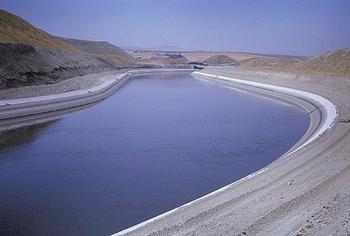Link between Two Canals Could Ease California’s Water Crisis
TRACY, California, October 14, 2010 (ENS) – A host of federal, state and local officials and business leaders today celebrated the start of construction on a $28 million underground link between two Central Valley canals south of the Sacramento-San Joaquin River Delta.
When complete in 2012, the Delta-Mendota Canal/California Aqueduct Intertie project is expected to improve water supply reliability south of the Delta, one of the world’s most productive agricultural regions, which relies on irrigation to grow fruits, nuts and vegetables.
The Intertie is located in an unincorporated area of the San Joaquin Valley in Alameda County, west of the city of Tracy. The site is in a rural agricultural area that is owned by the state and federal governments.
“Linking of these two canals by a new underground pipeline and pumping plant will improve water supply reliability in a part of California hardest hit by dry conditions and loss of jobs,” said Secretary of the Interior Ken Salazar.
 |
The Delta-Mendota Canal (Photo courtesy U.S. Bureau of Reclamation) |
Other speakers at the groundbreaking included U.S. Senator Dianne Feinstein and Congressmen Dennis Cardoza, Jim Costa, and Jerry McNerney.
In the FY 2010 Energy and Water Appropriations Bill, Congressman Costa passed an amendment to provide $10 million dollars for Valley water projects, and $4.1 million of these funds were allocated to the Intertie. In July, Costa helped secure $14.6 million in Recovery Act funding to begin construction of the project.
At the groundbreaking today, Costa said, “I fought for this project because more water equals more Valley jobs,” said Costa. “The Intertie will deliver more water to our region and help strengthen our economy. This project was stalled for years, but we used all of the tools at our disposal to make it a reality. This includes the earmarks and stimulus funding we secured to bring the Intertie online.”
Secretary for Natural Resources Lester Snow represented the state of California. Numerous other dignitaries present also included Deputy Secretary of the Interior David Hayes; Bureau of Reclamation Commissioner Mike Connor, members of the state legislature, leaders of local governments and irrigation districts and Mike Stearns, chairman of the Board of the San Luis and Delta-Mendota Water Authority.
A construction contract for the Intertie project was awarded to Shimmick Construction Co. of Oakland, California, in July. Shimmick will be building a pumping station and underground pipeline connection, installing four pumps and motors and building an electrical switchyard.
The project will provide about 160 construction jobs in an area hard hit by drought and job loss.
The Intertie could potentially increase average annual water deliveries to the Central Valley Project by as much as 35,000 acre-feet.
The Central Valley Project is a Bureau of Reclamation federal water project that provides irrigation and municipal water to much of California’s Central Valley.
The CVP accomplishes this by regulating and storing water in reservoirs in the water-rich northern half of the state, and transporting it to the water-poor southern Central Valley and its surroundings by means of a series of canals, aqueducts and pump plants, some shared with the California State Water Project.
The Intertie is expected to increase water deliveries to the Central Valley by addressing conveyance conditions in the Delta Mendota Canal that presently restrict use of the C.W. “Bill” Jones Pumping Plant near Tracy to less than its design capacity.
The Delta-Mendota Canal receives water pumped by the Jones plant and is the primary federal delivery facility sending water to Central Valley Project contractors south of the Delta, which include dozens of agricultural districts, as well as several industrial and municipal water districts.
The State Water Project’s California Aqueduct operates in much the way. The connection between the two will improve overall water supply reliability.
Secretary Salazar said, “Today’s groundbreaking is historic. It not only represents the efforts of all the partners gathered here to help alleviate California’s water crisis but also the timely action taken under President Obama’s American Recovery and Reinvestment Act to deliver water, and create jobs, while safeguarding the environment of the West.”
The year 2010 is the third dry year in a row for California with snowpack water content down to 66 percent of normal and reservoirs at low levels across the state.
Association of California Water Agencies Executive Director Timothy Quinn said Saturday, after a week of renewed negotiations on a state legislative package to address water issues, “It is critical to reach agreement on solutions to improve the reliability of the state’s water system and restore ecological health to the Delta.”
“Solving these problems is essential to the cities, farms and businesses that rely on our troubled water system,” Quinn said. “It is absolutely vital that we all work together to complete a package that can meet the goals of a reliable water supply and a restored Delta ecosystem.”
Copyright Environment News Service (ENS) 2010. All rights reserved.
© 2010 – 2012, Environment News Service. All rights reserved. Content may be quoted only with proper attribution and a direct link to the original article. Full reproduction is prohibited.
